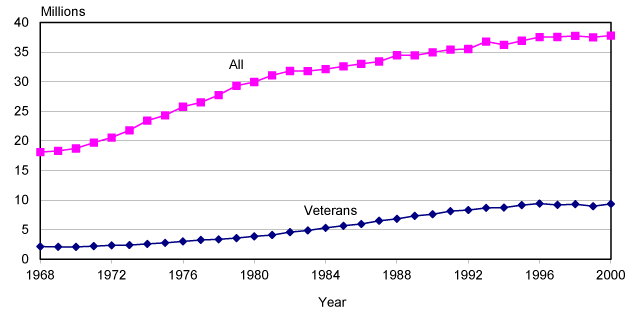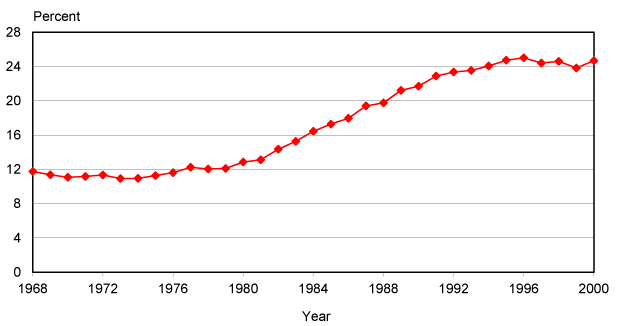Military Veterans and Social Security
Research and Statistics Note No. 2001-01 (released February 2001)
The authors are with the Division of Economic Research; Office of Research, Evaluation, and Statistics; Office of Policy.
The findings and conclusions presented in this paper are those of the authors and do not necessarily represent the views of the Social Security Administration.
Military veterans constitute an important subgroup of Social Security beneficiaries. One out of every four adult Social Security beneficiaries has served in the military, and two out of five are either veterans or reside with family members who are veterans. The number of veterans who receive Social Security has grown steadily since 1968 and is near an all-time high.
Military personnel have been covered under Social Security since 1957. Although Social Security benefits are based on average lifetime earnings, members of the military receive special credits that augment their earnings for the purpose of computing Social Security benefits. Those credits currently equal an additional $100 in earnings for each $300 the person receives in active-duty pay (total credits may not exceed $1,200 a year). The Congress enacted the special credits because it believed that military pay was too low, and that without the credits, Social Security benefits for veterans and their dependents would also be too low. Congress has also provided special credits for veterans who served before the military was brought under the Social Security system. For each month of service in the period from 1940 through 1956, a veteran is credited with $160 of earnings for the purpose of computing Social Security benefits.
Because veterans are a large subgroup of Social Security beneficiaries and because policymakers have shown a clear interest in their well-being, it is important to understand how veterans and their dependents are currently faring. Older veterans (aged 62 or older) enjoy high economic status, but disabled veterans and widows of veterans do not. The Department of Veterans Affairs (VA) has a number of programs that provide benefits to low-income disabled veterans, low-income widows of veterans, and all veterans in need of medical care, and the Social Security Administration (SSA) could potentially play a role in letting its beneficiaries know about the VA programs.
Characteristics of the Veteran and Social Security Populations
According to the March 2000 Current Population Survey (CPS), over 9 million Social Security beneficiaries are military veterans, accounting for about one-quarter of the adult Social Security beneficiary population (see Table 1).1 Tabulations from the March 2000 Current Population Survey (not shown in Table 1) indicate that about 42 percent of Social Security beneficiaries are either veterans or reside with family members who are veterans. Because economic well-being is measured on the basis of family income, the economic well-being of the Social Security population is strongly influenced by that of the veteran population. Also note how dependent the overall veteran population is on the Social Security program—of the 24.2 million veterans, 9.3 million (or 39 percent) receive Social Security benefits.
| Veterans receiving Social Security |
All veterans | All adult Social Security beneficiaries |
||||
|---|---|---|---|---|---|---|
| Number | Percent | Number | Percent | Number | Percent | |
| Total | 9,327,000 | 100.0 | 24,224,000 | 100.0 | 37,783,000 | 100.0 |
| Military service | ||||||
| World War II | 4,721,000 | 50.6 | 5,093,000 | 21.0 | 4,721,000 | 12.5 |
| Korean War | 2,896,000 | 31.0 | 3,469,000 | 14.3 | 2,896,000 | 7.7 |
| Vietnam | 606,000 | 6.5 | 7,477,000 | 30.9 | 606,000 | 1.6 |
| Other | 1,104,000 | 11.8 | 8,185,000 | 33.8 | 1,104,000 | 2.9 |
| Male | 9,058,000 | 97.1 | 22,995,000 | 94.9 | 16,233,000 | 43.0 |
| Age | ||||||
| Under 50 | 205,000 | 2.2 | 7,268,000 | 30.0 | 3,266,000 | 8.6 |
| 50 to 61 | 408,000 | 4.4 | 6,654,000 | 27.5 | 2,297,000 | 6.1 |
| 62 to 74 | 5,169,000 | 55.4 | 6,486,000 | 26.8 | 18,483,000 | 48.9 |
| 75 to 84 | 3,215,000 | 34.5 | 3,458,000 | 14.3 | 10,845,000 | 28.7 |
| Over 84 | 328,000 | 3.5 | 360,000 | 1.5 | 2,892,000 | 7.7 |
| Race and ethnicity | ||||||
| Black | 607,000 | 6.5 | 2,498,000 | 10.3 | 3,690,000 | 9.8 |
| Hispanic | 218,000 | 2.3 | 876,000 | 3.6 | 2,094,000 | 5.5 |
| Married | 6,991,000 | 75.0 | 17,544,000 | 72.4 | 20,653,000 | 54.7 |
| High-school diploma | 7,241,000 | 77.6 | 21,421,000 | 88.4 | 26,071,000 | 69.0 |
| Below 150% of poverty | 1,237,000 | 13.3 | 2,661,000 | 11.0 | 9,123,000 | 24.1 |
| No Medicare | 803,000 | 8.6 | 15,144,000 | 62.5 | 5,096,000 | 13.5 |
| SOURCE: March 2000 Current Population Survey. | ||||||
Most veterans who receive Social Security benefits are World War II veterans. There are 4.7 million such persons. That group is on the cusp of "very old age" (most of them are 75 or older), and its experiences (in terms of mortality, health conditions, and economic status) over the next 10 years will have important effects on the well-being of Social Security's oldest elderly and widowed populations.
The veteran population that receives Social Security is different from the overall Social Security population. The most striking, though not surprising, difference is the large percentage of men: veterans are overwhelmingly male. Other differences occur in marital status and education. Among the veteran population that receives Social Security benefits, 75 percent are married and about 78 percent have finished high school. The corresponding figures for the overall Social Security beneficiary population are 55 percent and 69 percent.
The economic status of veterans and other groups of Social Security beneficiaries also vary. Among veterans aged 62–74, only 3.9 percent are poor and only 11.8 percent have income below 150 percent of poverty (see Table 2). The low incidence of poverty and near poverty also holds for veterans aged 75 or older. However, veterans drawing Social Security who are younger than 62 have lower economic status, and nearly a third of them have income below 150 percent of poverty. Persons under 62 who receive Social Security are usually eligible on the basis of a disability and therefore may have little or no non-Social Security income.
| Below poverty | Below 125 percent of poverty |
Below 150 percent of poverty |
||||
|---|---|---|---|---|---|---|
| Number | Percent | Number | Percent | Number | Percent | |
| Veterans | ||||||
| Under 62 | 109,000 | 17.8 | 157,000 | 25.6 | 201,000 | 32.8 |
| 62–74 | 200,000 | 3.9 | 394,000 | 7.6 | 609,000 | 11.8 |
| 75–84 | 99,000 | 3.1 | 243,000 | 7.6 | 375,000 | 11.7 |
| Over 84 | 6,000 | 1.9 | 25,000 | 7.6 | 52,000 | 15.9 |
| Male nonveterans | ||||||
| Under 62 | 407,000 | 19.5 | 630,000 | 30.1 | 839,000 | 40.1 |
| 62–74 | 300,000 | 9.6 | 501,000 | 16.0 | 692,000 | 22.1 |
| 75–84 | 105,000 | 8.0 | 207,000 | 15.7 | 327,000 | 24.8 |
| Over 84 | 58,000 | 9.3 | 101,000 | 16.1 | 165,000 | 26.4 |
| All widows | ||||||
| Under 62 | 138,000 | 27.2 | 197,000 | 39.0 | 238,000 | 47.1 |
| 62–74 | 430,000 | 13.8 | 717,000 | 23.0 | 1,070,000 | 34.3 |
| 75–84 | 512,000 | 14.4 | 883,000 | 24.9 | 1,287,000 | 36.3 |
| Over 84 | 248,000 | 16.1 | 453,000 | 29.5 | 691,000 | 44.9 |
| SOURCE: March 2000 Current Population Survey. | ||||||
Men typically have lower poverty rates than women, and the low incidence of poverty among aged veterans may result in part from the fact that veterans are a disproportionately male group. However, when one compares veterans with men who are not veterans, it is clear that other factors are at work as well. Among the older age groups, men who did not serve in the military are more than twice as likely as veterans to be poor.
Although veterans enjoy high economic status, there is no guarantee that their survivors will. Poverty among widows tends to be high. To provide some perspective, the last set of numbers in Table 2 pertain to the economic status of widows. Those data are for all widows receiving Social Security, not necessarily widows of veterans.2 In particular, the "oldest old" widows (those aged 85 or older) have a high incidence of poverty and near poverty: 16.1 percent are poor, and 44.9 percent have income below 150 percent of poverty. That is especially relevant because a large number of women will become widows of veterans in the coming decade. Among current Social Security beneficiaries, about 2.5 million married veterans are 75 or older.
Trends in Growth of the Veteran and Social Security Populations
Between 1968 and 2000, the overall Social Security population approximately doubled, whereas the number of veterans receiving Social Security more than quadrupled (see Chart 1).3 The percentage of Social Security beneficiaries who have served in the military has also increased (see Chart 2).
Social Security beneficiaries

Percentage of beneficiaries who are veterans

With the exception of 1996, the current number of veterans who draw Social Security (9,327,000) is at an all-time high. The current percentage of Social Security beneficiaries who are veterans (24.7) is, with the exception of 1995 and 1996, also at an all-time high.
The World War II veterans are on the cusp of very old age and over the next several years will experience high mortality. The veteran population that receives Social Security will change over the next 10 to 15 years but will remain large because the Vietnam-era veterans will replace the veterans of World War II and the Korean War. The VA projects that veterans over the age of 65 will number 8.5 million in 2010 and 8.2 million in 2020.4
Notes
1 The CPS does not identify whether persons under the age of 15 receive Social Security. Figures in this note generally pertain to the "adult" population (age 15 or older). Also, because of the sample design of the CPS, figures in this note pertain to the noninstitutionalized population residing in the 50 states or the District of Columbia.
2 Evidence from the 1991 New Beneficiary Followup suggests that widows of veterans are somewhat better off than the overall widowed population, but the difference is not dramatic. Among widows of veterans who died in the previous 9 years, 12.2 percent had income at or below poverty. The figure for all widows is 14.0 percent.
3 The data discussed in this section and in Charts 1 and 2 are based on March CPS files from 1968 through 2000. Totals for veterans do not include women before 1989. Totals for Social Security beneficiaries do not include children. Before 1980, children are defined as persons under age 14. Starting with 1980, children are persons under 15.
4 Department of Veterans Affairs, The Changing Veteran Population: 1990–2020 (March 2000). Report located at www.va.gov/vetdata/Demograhics/index.htm on December 29, 2000.